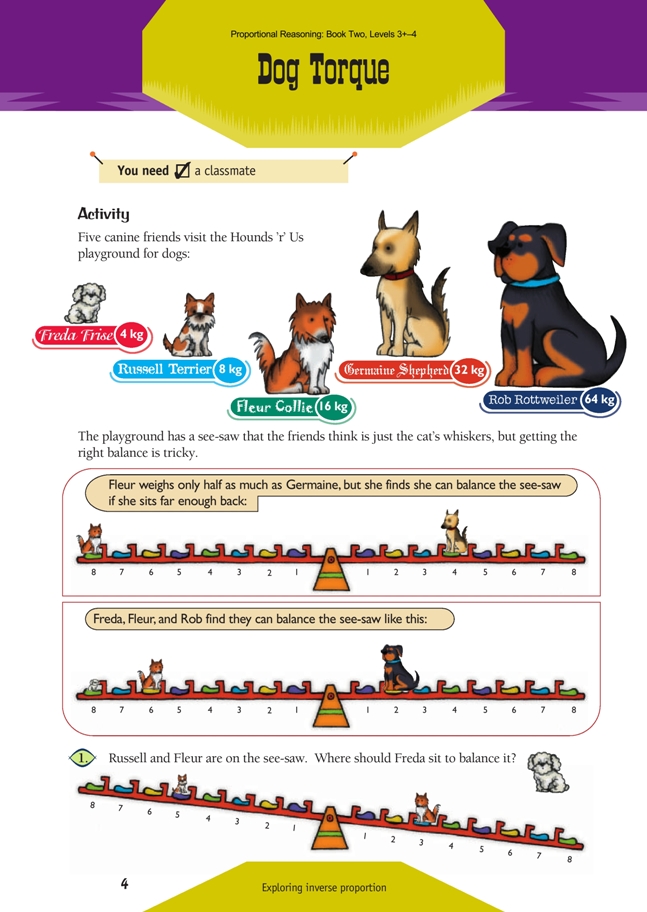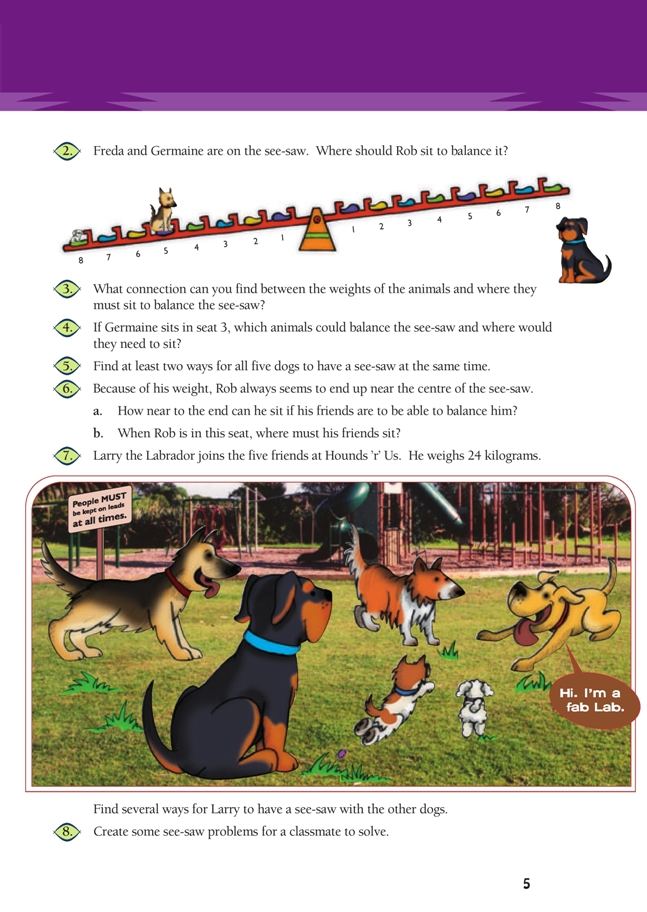This is a level 5 number activity from the Figure It Out series. It relates to Stage 8 of the Number Framework.
A PDF of the student activity is included.
Click on the image to enlarge it. Click again to close. Download PDF (1397 KB)
use proportions to solve seesaw weight distance- relationships
Number Framework Links
Use this activity to develop confidence in students who are beginning to use advanced proportional strategies (stage 8).
A classmate
In this activity, students learn to balance distance–weight relationships in the context of a fun pplication of the Principle of Balanced Torques. In the process, they develop meaning for the concept of an equation.
Definitions:
• Weight is used in the student book instead of the more correct mass. This is because it is the word that students know and use. Strictly speaking, weight is the gravitational force that the Earth exerts on a mass: Fleur has a mass of 16 kg; her weight is around 160 N (Newtons).
• Torque can be thought of as a force that, when applied to a lever (a see-saw is a lever), makes it turn. Torque = the force applied to a lever multiplied by its distance from the fulcrum; it is usually measured in newton-metres (Nm).
Students will know from experience that a light person can balance a heavy person on a see-saw as long as the heavy person sits closer to the fulcrum. This prior knowledge can provide a lead-in to a discussion of the examples given at the start of this activity.
One approach to the activity is to put the students in pairs or small problem-solving groups and see how far they get in understanding the situations presented in the examples. If you do this, get them to report back with their findings before they get too far into the actual questions.
An alternative approach is an introductory whole-group discussion, using questions similar to these to focus the thinking:
• What do you notice about where the two dogs (Fleur and Germaine) are sitting?
• Why is Fleur so far back?
• If you compare the weights of the two dogs, what do you notice?
• What would happen to the see-saw if Germaine moved one seat forward? Could Fleur then balance the see-saw? Where would she have to sit?
If your students can’t get from the general idea to the mathematical distance–weight relationship, you may find it helpful to use materials. The best piece of equipment is a mathematical balance (equaliser balance), which is available from any of the major equipment suppliers. Using this balance, you can suspend weights at different points along the arms and find by experimentation how to balance a change at one end with an appropriate change at the other.
The key understandings are:
• The closer a dog is to the end of the see-saw, the greater the effect of its weight.
• The torque a dog exerts is found by multiplying its distance from the fulcrum (centre) by its weight.
• If more than one dog sits on the same end of the see-saw, the combined effect of their torques is found by adding their individual torques.
• The torques acting on both sides of the see-saw can be tidily expressed as an equation.
The mathematical ideas are easier for a student to understand than this suggests!
In the first example, Fleur weighs 16 kg and is in seat 8. Germaine weighs twice as much (32 kg) but is only half the distance from the fulcrum (seat 4). This information can be represented in the equation 16 x 8 = 32 x 4. Both sides of the equation equal 128, showing that the torques acting on each end of the see-saw are the same, and the see-saw is balanced. Note that if the torques were not the same, we would not have an equation and would have to use an inequality sign (< or >)
to express the relationship mathematically. (For example: 16 x 4 > 8 x 6.)
In the second example, Freda (4 x 8) + Fleur (16 x 6) = Rob (64 x 2)
32 + 96 = 128
128 = 128
The students can now discuss and record the situations shown in questions 1 and 2. In question 1, Fleur exerts a torque of 16 x 3 = 48; Russell exerts a torque of 8 x 5 = 40. To balance the see-saw, Freda will have to sit on Russell’s end and exert a torque of 8. As she only weighs 4 kg, she will have to sit in seat 2 (4 x 2 = 8). In question 2, Freda exerts a torque of 4 x 8 = 32; Germaine exerts a torque of 32 x 5 = 160. Their combined torque is 32 + 160 = 192. Rob weighs 64 kg.
To exert of torque of 192, he will need to sit in seat 3 (64 x 3 = 192). Expect your students to write this information in the form of a complete equation.
In question 4, the starting point is the torque that Germaine exerts in seat 3 (32 x 3 = 96). Encourage your students to come up with a variety of possible solutions, representing each as an equation. Questions 5–8 are all a matter of applying the principles learned and discussed to this point. Students could work in pairs. They will find it helpful to use diagrams and should show that their solutions are correct by writing the appropriate equations.
Answers to Activity
1. Seat 2. (16 x 3 = 8 x 5 + 4 x 2)
2. Seat 3. (32 x 5 + 4 x 8 = 64 x 3)
3. The closer the animal is to the end of the see-saw, the greater the effect of its weight (the greater the torque it exerts). A dog weighing 8 kg sitting in seat 4 exerts the same torque as a dog weighing 16 kg sitting in seat 2. (8 x 4 = 16 x 2)
4. Answers will vary, but they must match the torque being exerted by Germaine (32 x 3 = 96 units).
Possible answers include:
• Fleur at seat 2 and Russell at seat 8 (16 x 2 + 8 x 8 = 96)
• Rob at seat 1 and Fleur at seat 2 (64 x 1 + 16 x 2 = 96)
• Fleur at seat 6 (16 x 6 = 96)
• Rob at seat 1 and Freda at seat 8 (64 x 1 + 4 x 8 = 96)
• Freda at seat 2, Fleur at seat 3, and Russell at seat 5 (4 x 2 + 16 x 3 + 8 x 5 = 96)
5. Possible answers include:
6. a. Rob can sit in seat 6, but not in seats 7 or 8.
(The maximum torque that can be exerted by the other dogs is 8 x 32 + 7 x 16 + 6 x 8 + 5 x 4 = 436. 436 ÷ 64 [64 is Rob’s mass] = 6.8, showing that Rob can’t sit further back than seat 6.)
b. A possible answer is Germaine at seat 8, Fleur at seat 7, Freda at seat 2, and Russell at seat 1.
7. Possible answers include:
• End 1: Larry in seat 1; End 2: Freda in seat 6.
• End 1: Larry in seat 4 and Russell in seat 6; End 2: Freda in seat 4, Germaine in seat 3, and Fleur in seat 2.
• End 1: Germaine in seat 8, Larry in seat 7, Freda in seat 6, and Fleur in seat 5;
End 2: Russell in seat 2 and Rob in seat 8.
8. Answers will vary. Many problems are possible.


